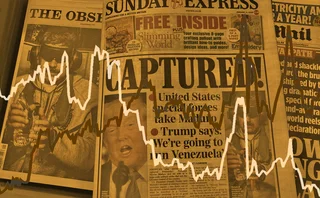
North America review
Izzy Nelken examines the choices available to high-net-worth individuals in the North American structured note market, and finds that there are some regulatory issues that need to be taken into consideration
Enhanced yield structures – As interest rates in the US and many other countries are at or near long term historical lows, there are many structures in which the client “sells” options in order to receive higher interest rates. This ties in with the following trend.
Structures that are “short volatility”. Annual reports of many banks reveal rising value-at-risk levels. Coupled with the declines in volatility levels in 2003–2004, this would indicate rising exposure to volatility. Many trading desks are rumoured to beat or close to their volatility exposure limits. Such desks are interested in issuing any structure that would enable them to buy volatility back from the markets.
Inverse floaters – There are many market participants who predict that short term interest rates are set to rise in the US. These investors are very interested in obtaining Floating Rate Notes (FRN). To accommodate such investors, an issuer may decide to issue a pair of FRN and an inverse FRN. Together, these are equivalent to a fixed rate bond.
The buyers
These types of structured note are aimed at wealthy individuals. Their minimal denomination is typically $100,000, with some as low as $10,000. Such an individual would be “hard pressed” to create similar payout profiles by themselves. In addition, individuals can not purchase the options required to create these structures because of the relatively small investment size.
The sellers
According to data from the US Office of the Comptroller of the Currency, derivatives activities are concentrated among roughly seven major banks. These same banks have the resources, capacity and willingness to issue structured notes. These are then sold to other institutions who distribute the notes piecemeal to the final clients. The distribution banks engage in a “back-to-back”
transaction. They purchase a note from one of the major dealers and then sell the same note to investors. The distributor has, in effect, unlocked the “wholesale” market and enabled individuals to express the same views.
Regulatory concerns
Regulators (eg the Federal Deposit Insurance Corporation) have several concerns that are related to the structured products:
After a bank sells the instrument, it must be marked to market. As there is no secondary trading in the instrument, its value is uncertain. Therefore, banks “mark to model” and compute the value according to some quantitative model. This is typically a highly mathematical model. Further, the model has many parameters that are very difficult to verify. There is therefore uncertainty over the value of the structure after it has been sold. The regulator (and the bank’s own risk management division) are faced with the almost impossible task of independently verifying the price of the structure on a continual basis.
Hedging and risk management – as the hedge ratios and risk capital are computed by the very same mathematical models, there are questions about the accuracy of the hedging parameters and whether the bank has allocated sufficient risk capital.
Concentration – there are only about seven banks that can independently price the structured products and are willing to “warehouse” the risks of selling them. All other institutions trade these on a “back to back” basis. This concentration magnifies the two previous problems.
Enhanced yield structures
A very popular structure is the “capped floater”. These were popular during 1993 and 1994, when interest rates were relatively low, and the same structures are appearing again. Essentially a floating rate bond that an either be called at a later date or, if not called, it becomes a fixed-rate note. The buyer of the note gets an enhanced coupon for selling the call. These notes have been issued by Private banks as well as US Government agencies. For example a recent issue pays Libor +x bps. for the first two years and then a fixed rate of R%, if not called.
In this type of structure, the holder typically purchases a floating rate note and sells as interest rate cap. Usually interest rate caps are “cash settled”, that is the seller of the cap will make a payment that is determined according to the difference between Libor and the strike. However, we can think of the “physical settlement” of an interest rate cap. The seller of the cap agrees to land money to the buyer at a pre-determined interest rate.
If interest rates stay low, the seller of the note will not want to borrow at (the relatively high) fixed rate and will call the note. Thus calling the note is equivalent to not exercising the cap. On the other hand, should rates rise, the issuer will want to borrow at the. predetermined fixed rate and will refrain from calling the bond. Thus not exercising the call is equivalent to exercising the cap.
In many cases, the issuer who has purchased an interest rate cap from the buyer of the note, simply goes out and sells the cap in the open market. Of course, the cap is sold for more than it was purchased and the issuer simply enjoys sub-Libor funding.
Short volatility
A recent six-year Canadian structure promises to pay a coupon that is tied to the average performance of a group of about half a dozen stocks, with a minimal coupon of zero. The performance is calculated from the issue date until the coupon date. However, each stock that exhibits a positive performance, that performance is taken as X%. In this structure X% is quite high, in the neighbourhood of 10%.
Now, assume that volatility is low, and that some stocks have small negative returns while others have small positive returns. As all the positive returns are replaced by X% before calculating the average, the structure will have a coupon which is close to X%. For example, if the returns are 0.01%, –0.01%, 0.01%, –0.01%, 0.01% and –0.01%, we will instead average X%, –0.01%, X%, –0.01%, X% and –0.01%, thus getting a result close to X% and a respectable coupon.
On the other hand, if volatility increases, and the returns are, for example, 40%, –40%, 40%, –40%, 40% and –40%, the structure will average X%, –40%, X%, –40%, X% and –40%. The average will be negative and the bond will pay a coupon of zero.
In addition if any of the companies whose stocks are referenced in this structure will default, that stock price will drop severely. The return on that stock might be close to -100%. Thus the structure will pay a zero coupon no matter what else happens.
In a fashion, the buyer of the structure is protecting the seller from a default in any of the companies referenced.
Inverse floaters
Many investors are convinced that interest rates are at or near their long-term historical lows and are set to rise. Such investors are not interested in fixed rate bonds. Fixed rate bonds prices fall as interest rates rise. Instead, these investors are interested in notes whose coupon is tied to the level of Libor rates, so called floating Rate Notes or FRNs.
But many issuers are interested in paying fixed rates on their loans. Wall Street takes a fixed-rate bond and converts it into a combination of: a floating rate bond FRN; an inverse floater IFRN; and an interest rate cap.
Consider an issuer willing to borrow $200 million at 5%. This debt is equivalent to borrowing $100 million at Libor and an additional $100 million at 5%-Libor. Additionally an interest rate cap is purchased to hedge the possibility that Libor will rise higher than 5%.
This is a very simplistic example. Other structures have a sequence of call options as well as other features.
The IFRN buyer is compensated by a relatively large coupon should rates stay low. If rates rise, on the other hand, they could end up owning a zero coupon bond.
Izzy Nelken is president of Illinois-based derivatives consultancy Super Computer Consulting. He is also a lecturer in the mathematics department at the University of Chicago. He can be reached at izzy@supercc.com
Only users who have a paid subscription or are part of a corporate subscription are able to print or copy content.
To access these options, along with all other subscription benefits, please contact info@risk.net or view our subscription options here: http://subscriptions.risk.net/subscribe
You are currently unable to print this content. Please contact info@risk.net to find out more.
You are currently unable to copy this content. Please contact info@risk.net to find out more.
Copyright Infopro Digital Limited. All rights reserved.
As outlined in our terms and conditions, https://www.infopro-digital.com/terms-and-conditions/subscriptions/ (point 2.4), printing is limited to a single copy.
If you would like to purchase additional rights please email info@risk.net
Copyright Infopro Digital Limited. All rights reserved.
You may share this content using our article tools. As outlined in our terms and conditions, https://www.infopro-digital.com/terms-and-conditions/subscriptions/ (clause 2.4), an Authorised User may only make one copy of the materials for their own personal use. You must also comply with the restrictions in clause 2.5.
If you would like to purchase additional rights please email info@risk.net
More on Markets
Trump’s LatAm gambit spurs FX hedging rush
Venezuela op boosts risk reversals as investors look to protect carry trades
One Trading brings 24/7 equity trading to Europe
Start-up exchange will launch perpetual futures Clob in Q1 after AFM nod
FXGO volumes surge despite fee switch-on
Dealers split on whether levy is behind volume increases across SDPs
Banks hope new axe platform will cut bond trading costs
Dealer-backed TP Icap venture aims to disrupt dominant trio of Bloomberg, MarketAxess and Tradeweb
Kyriba sees uptake in AI-assisted FX hedging tools
Automated data collection and cleaning helps corporates create better hedges and has cut unexplained P&L moves by 87%, says vendor
Review of 2025: It’s the end of the world, and it feels fine
Markets proved resilient as Trump redefined US policies – but questions are piling up about 2026 and beyond
Does crypto really need T+0 for everything?
Instant settlement brings its own risks but doesn’t need to be the default, writes BridgePort’s Soriano
Asset managers prep autocall ETFs with assets tipped to hit $30bn
Actively managed strategies wait in the wings after systematic approach nets Calamos $500m







